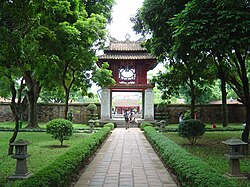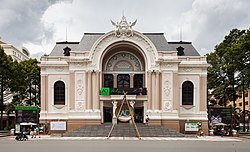Culture
Vietnamese culture is considered part of the Sinosphere. Vietnam's culture has developed over the centuries from indigenous ancient Đông Sơn culture with wet rice cultivation as its economic base.[44][47] Some elements of the nation's culture have Chinese origins, drawing on elements of Confucianism, Mahāyāna Buddhism, and Taoism in its traditional political system and philosophy.[443][444] Vietnamese society is structured around làng (ancestral villages);[445] all Vietnamese mark a common ancestral anniversary on the tenth day of the third lunar month.[446][447] The influence of Chinese culture such as the Cantonese, Hakka, Hokkien, and Hainanese cultures is more evident in the north where Buddhism is strongly entwined with popular culture.[448] Despite this, there are Chinatowns in the south, such as in Chợ Lớn, where many Chinese have intermarried with Kinh and are indistinguishable among them.[449] In the central and southern parts of Vietnam, traces of Champa and Khmer culture are evidenced through the remains of ruins, artefacts as well within their population as the successor of the ancient Sa Huỳnh culture.[450][451] In recent centuries, Western cultures have become popular among recent generations of Vietnamese.[444]

The traditional focuses of Vietnamese culture are based on humanity (nhân nghĩa) and harmony (hòa) in which family and community values are highly regarded.[448] Vietnam reveres a number of key cultural symbols,[452] such as the Vietnamese dragon which is derived from crocodile and snake imagery; Vietnam's national father, Lạc Long Quân is depicted as a holy dragon.[446][453][454] The lạc is a holy bird representing Vietnam's national mother Âu Cơ. Other prominent images that are also revered are the turtle, buffalo and horse.[455] Many Vietnamese also believe in the supernatural and spiritualism where illness can be brought on by a curse or sorcery or caused by non-observance of a religious ethic. Traditional medical practitioners, amulets and other forms of spiritual protection and religious practices may be employed to treat the ill person.[456] In the modern era, the cultural life of Vietnam has been deeply influenced by government-controlled media and cultural programmes.[444] For many decades, foreign cultural influences, especially those of Western origin, were shunned. But since the recent reformation, Vietnam has seen a greater exposure to neighbouring Southeast Asian, East Asian as well to Western culture and media.[457]
The main Vietnamese formal dress, the áo dài, is worn for special occasions such as weddings and religious festivals. White áo dài is the required uniform for girls in many high schools across the country. Other examples of traditional Vietnamese clothing include the áo tứ thân, a four-piece woman's dress; the áo ngũ, a form of the thân in five-piece form, mostly worn in the north of the country; the yếm, a woman's undergarment; the áo bà ba, rural working "pyjamas" for men and women; the áo gấm, a formal brocade tunic for government receptions; and the áo the, a variant of the áo gấm worn by grooms at weddings.[458][459] Traditional headwear includes the standard conical nón lá, the "lampshade-like" nón quai thao, and the traditional turban, khăn vấn.[459][460] In tourism, a number of popular cultural destinations include the former Imperial City of Huế, the World Heritage Sites of Phong Nha – Kẻ Bàng National Park, Hội An and Mỹ Sơn, coastal regions such as Nha Trang, the caves of Hạ Long Bay and the Marble Mountains.[461]



